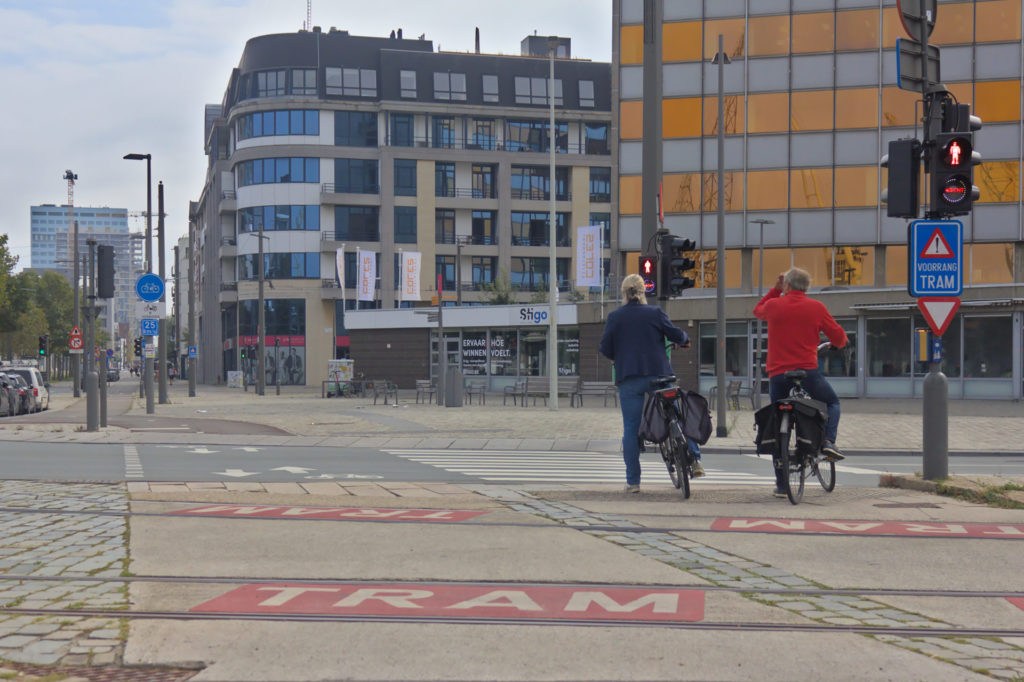A 35-year-old cyclist who fell on wet tram tracks in Ghent died from his injuries last month, raising concerns about a city whose tram accident figures are among the worst in the world.
In 2018, a quarter of all bicycle accidents in the Belgian city were related to tram tracks. That’s around 500 accidents in a year.
“It’s a very difficult problem,” Dr. Cathelijne Lyphout of Ghent University Hospital (UZ Gent) told The Brussels Times. “If there were an easy solution, it would have already been implemented.”
UZ Gent conducted a study among all four emergency departments in the city of Ghent that involved giving questionnaires to people admitted to hospital after a cycling accident involving tram tracks.
They ended up with 149 cases, representing one-third of all cycling accidents that resulted in a hospital visit.
“What we found was that a lot of people fell when their tires got stuck in the tracks or slipped when crossing tracks, especially when the conditions were wet,” said Lyphout.
An under-reported issue
But the data doesn’t give a complete picture of the problem, nor its scale.
“It’s definitely an under-representation of people who've fallen onto the tracks,” Lyphout said, pointing out that the study only includes those who went to a hospital following a cycling accident involving tram tracks. Furthermore, only 5 percent of respondents filed any sort of accident report with the police.
“When you have an accident on a public road, you can go and put a declaration down with the police,” said Lyphout, explaining that this allows the city to collect better data about these sorts of hazards.
Fatal falls like the one last month are rare. The injuries the hospital usually sees are relatively minor, such as fractures and lacerations.
According to the study published in March of this year, 42 patients had fractures, 39 patients required wound sutures and 79 and 49 patients suffered from bruising and abrasions, respectively.
“Tram tracks are potentially dangerous and may lead to clinically important injuries and a significant number of days off work,” the study concluded. “More generally, roads in city centres crowded with cars, pedestrians, cyclists and on-road tram tracks (crossings) are probably the most dangerous for cyclists.”
A tricky problem to solve
The city centre of Ghent has little room for substantive changes to infrastructure.
“Ghent has a very old historical centre with a lot of narrow streets, which makes it very difficult to separate tram tracks from cyclists... you can’t just demolish the old buildings to make new roads,” said Lyphout.
“These are protected houses from the 1600s. The city can’t be rebuilt. You have to just close off streets for one or the other, and that’s not an easy thing to do.”
Ghent’s alderman for mobility Filip Watteeuw (Groen) also acknowledged that there’s no room for separate cycle tracks in the historic city centre.
“We need those trams as well,” Watteeuw said, adding that addressing the problem is a responsibility shared between multiple authorities, including the tram operator De Lijn, the city and other agencies.
Fewer obstacles for a safer city
Ghent does have a mobility plan that aims to improve safety for cyclists, but it mainly entails reducing the presence of cars.
“That’s a really good thing because then more people use trams and bikes, but that doesn't solve this particular problem,” said Lyphout.
One thing that could help, she says, is keeping the roads around the tram tracks in good shape and free of obstacles.
“Because of the accident that happened last month, with the gentleman who unfortunately died, I think they should avoid implementing other unneccesary obstacles that could aggravate injuries when people fall,” Lyphout added.
“That man landed on a little pole. If that pole hadn't been there, he probably wouldn’t have been injured so badly.”
She said that efforts to teach people how to interact with the tram tracks would go a long way, as well.
“We see a lot of accidents often with young people, which might coincide with new students in Ghent city centre who aren't used to the tram tracks,” said Lyphout.
A cyclist herself, she recommends crossing them diagonally at an angle as close to 90 degrees as possible.
“If you can't do that in a controlled way, just get off your bike and walk, and cross the road. Some places have too many tram tracks and it's too difficult to get your direction right. Don't be afraid to just get off your bike and walk if you think it’s too dangerous.”
For better protection, cyclists could also wear a helmet. Only 15 patients (11.5 percent) in the UZ Gent study were wearing a helmet at the time of the accident.
“A lot of people in Belgium don’t wear helmets. It helps to wear one,” said Lyphout.
Ghent says it’s working on the problem.
They’re looking to improve signage and organise cycling routes that avoid the tram tracks as much as possible while investigating more closely how such accidents happen.
The UZ Gent study suggests focusing on “hotspots” for accidents involving trams and cyclists, as has been done in The Netherlands.
“Studies conducted in Amsterdam have shown that identifying accident ‘hotspots’ and separating trams from other vehicles and bicycles in these areas may lead to a significant reduction in accidents,” the study said.
“We identified a few of these ‘hotspots’ in Ghent, mainly located in the city centre. Local policy makers should focus on these hotspots in an attempt to lower the number of tram tracks related cycling injuries.”

